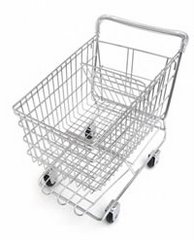In a real supermarket the user benefits from distributed cognition, whereby an individual is constantly bombarded by information about products and choices, enabling them to go shopping without a list because the environment triggers off memories for them. For this reason and the purposes of using established mental models, the system will heavily make use of a visual representation similar to a real store - unlike online shopping, which is list based.
The visual output
To this end, we decided a virtual reality (VR) helmet would be a good choice, providing an immersing environment.

Our (re-)design

Equipped with some knowledge of our audience, we set out to improve the design to be more user friendly. Our prototype (above) was more compact, lightweight and less intruding. It was designed to appear similar to sunglasses in design and feel, making the audience feel more comfortable and hence more likely to explore.
We made assumptions that such a technology would be possible in the future, be wireless and cheap to purchase. Other aspects of our prototype will be discussed in subsequent posts.

No comments:
Post a Comment